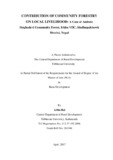Please use this identifier to cite or link to this item:
https://elibrary.tucl.edu.np/handle/123456789/2334| Title: | Contribution of Community Forestry on Local Livelihood |
| Other Titles: | A Case of Ambote Singhadevi Community Forest, Irkhu VDC, Sindhupalchowk District, Nepal |
| Authors: | Rai, Arbin |
| Keywords: | Community forestry;Livelihood Capitals,;Forest Management |
| Issue Date: | Apr-2017 |
| Publisher: | Central Department of Rural Development Tribhuvan University, Kathmandu |
| Abstract: | Community forests have existed in their modern form in Nepal since 1987, when the government began a phased handover of state-owned forest to communities. The government hoped that this would be an incentive for communities to conserve and restore what were by that point heavily degraded forests. Under this theme, Ambote Singhadevi, Community Forest which cover an area of 50.128 hectares and located in Irkhu VDC, Ward no. 7 of Sindhupalchowk District was handed over to community in July 2004 AD. Since the handover of the forest, there has been significant change in greenery as well as on livelihood of the local people who were dependent upon forest and forest products for their daily needs. The main objective of the study entitled “Contribution of Community Forestry on Local Livelihood: A Case of Ambote Singhadevi Community Forest, Sindhupalchowk” was to assess the status of socio-economic condition, adopted forest management strategies and its contribution on livelihood of forest dependent people. Livelihood assessment was determined using “Sustainable Livelihood Framework Guidance Sheet” prepared by DIFID. Assessment of livelihood on forest dependent community was based on field observation, Key Informant Interview and Focus Group Discussion where judgmental scoring method was applied. Questionnaire for which was developed on the basis of Sustainable Livelihood Framework Guidance Sheet. The total average scores for five livelihood capitals namely human, physical, social, financial and natural capitals which were used to assess the livelihood were found to be 1.765, 1.617, 2.361, 2.042 and 2.702 respectively. The result illustrated that the forest under study had significantly contributed to enhance the condition of human, social and natural capitals. The contribution was noticeable in terms of physical capital but the condition of financial capital was found to be dissatisfactory. |
| URI: | http://elibrary.tucl.edu.np/handle/123456789/2334 |
| Appears in Collections: | Rural Development |
Items in DSpace are protected by copyright, with all rights reserved, unless otherwise indicated.

